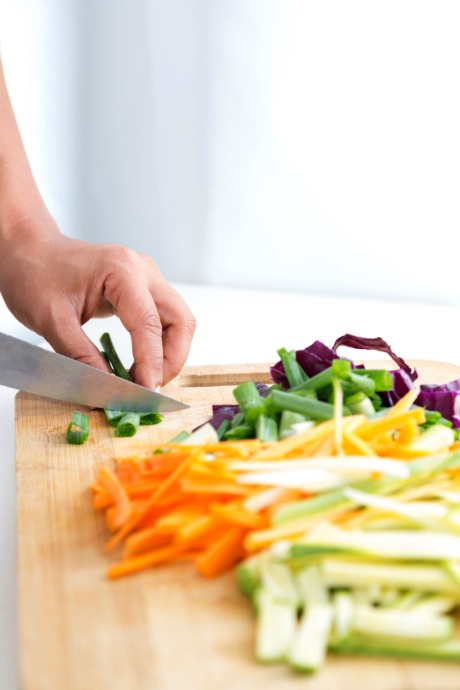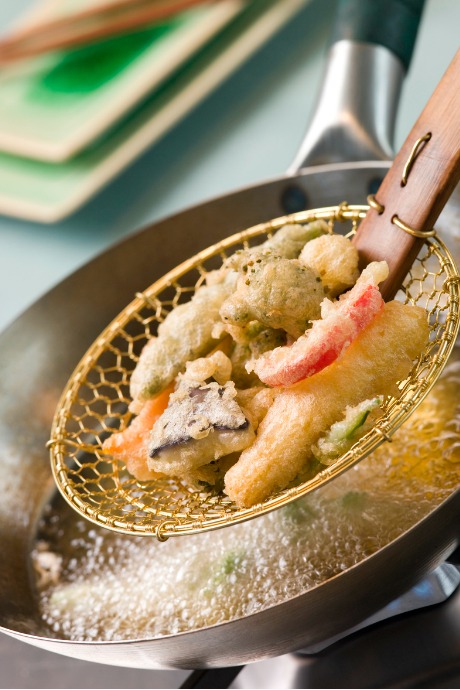Keep It Light With Vegetable Tempura
Posted by Julie on Sep 13th 2018
We love trying to recreate our favorite dishes from ethnic restaurants. One of our cooking goals is to make tempura at home, even if it’s nowhere near as good as the tempura we’ve had in Japanese restaurants.
We searched for secret tips to making vegetable tempura turn out light, crispy, and delicious. We’re happy to report that there are some key elements to successful tempura you might not already know, even if you’re a seasoned deep-fryer.
Vegetable Tempura: Choose and Prep Your Vegetables
Preparing your vegetables is the most labor-intensive part of making vegetable tempura. Tempura is meant to complement the flavor of the vegetables, not cover it up. Choose any fresh, seasonal vegetables you like: onion, zucchini, sweet potato, broccoli, peas, carrots, and mushrooms are just a few ideas. Incorporate traditional Japanese ingredients with lotus root and shiso leaves.

Japanese food blogger Maki Itoh, from Just Hungry, offers a few tips learned from her mother, whose tempura she has sought to replicate. Our favorite tip for vegetable prep is to slice and chop well in advance, and leave your vegetables to dry. We like this option better than patting vegetables dry with a paper towel. Also, cut hard vegetables into small, thin pieces so they cook quickly. If they are too large and thick, the batter will cook before the vegetables do.
Vegetable Tempura: Fill Your Pot
Because you are deep frying these vegetables, you will need a suitable container such as a wok or deep cast iron pan. We recommend the Le Creuset Wok because the cast iron retains heat well, and the enameled surface is easy to clean. It also has a generous 5-quart capacity and is deep enough to safely hold your cooking oil. You can also use a cast iron Dutch oven, such as this one from Finex that also has a 5-quart capacity.
You can use vegetable oil for frying. It’s inexpensive, and it has a neutral flavor and a high smoke point. Nami from Just One Cookbook (another Japanese recipe blog) suggests adding some sesame oil for additional flavor if you like.

Your oil needs to be in the temperature range of 340-360F. In fact, we recommend you aim for the high end of this range, as does Nami. You will better understand why, once we cover the details of tempura batter.
If you don’t own a kitchen thermometer to help you measure the oil temperature, try this shortcut from The Spruce:
Check the temperature of the oil by dropping a little bit of batter into the oil. If the batter comes up right away instead of sinking to the bottom of the pan, it's higher than 370F. If the batter goes halfway to the bottom and comes up, it's about 340 to 360F.
But before you can do that, you have to get your batter ready.
Vegetable Tempura: Assemble Your Batter
The batter is the real secret to light, crispy tempura, and the secret to tempura batter is to keep it cold and barely mix it. That’s why you want to have all of your vegetables prepared and your oil ready for frying before you assemble your batter.
Don’t buy a pre-made mix; tempura batter is simple. All you need is ice cold water, flour, and an egg. Each of these ingredients should be cold, and you should only mix them directly before you plan to begin dredging, dipping, and frying. All-purpose flour will work fine, but The Spruce suggests using cake flour to help minimize gluten formation.
Nami recommends using chopsticks to stir the batter. Whatever you do, don’t use a whisk. If you mix the batter too thoroughly, gluten will form, and the exterior will fry up chewy instead of crispy. Likewise, if you make the batter too far in advance, gluten will form, even if you don’t mix it too much.
Vegetable Tempura: Fry Your Vegetables
Your vegetables are sliced and diced, your oil is hot, and your batter is cold. It’s time to start frying!
Remember that your cold ingredients will lower the temperature of the oil as you add them to the pot. That’s why it’s helpful to start with oil close to 360F. You also don’t want to add too many vegetables to the pot at once, which will also lower the oil temperature. If the oil isn’t hot enough, the batter will get greasy instead of staying light and crispy. If the oil is too hot, you can add more oil or another vegetable or two to help bring down the temperature.

The batter should adhere well to dry vegetables, but you can also dredge them in flour before dipping in the batter. You can also roll the batter-dipped vegetables in crispy panko bread crumbs for extra crunch. However, too much flour and batter can give your vegetable tempura a mushy texture. Use a light hand with both.
While your vegetables are cooking, you will see bubbles around them. The Spruce cautions that the size of the bubbles are a good indicator of doneness: larger bubbles mean it’s time to remove your tempura from the oil. Be sure to strain debris from the oil so it doesn’t burn and give your tempura an off flavor.
Vegetable Tempura: Ready to Serve
You can drain your tempura on a cooling rack over paper towels. But don’t let it sit for long — tempura should be served hot! Try it with dipping sauce or over plain white rice.
 Free shipping over $49
Free shipping over $49










